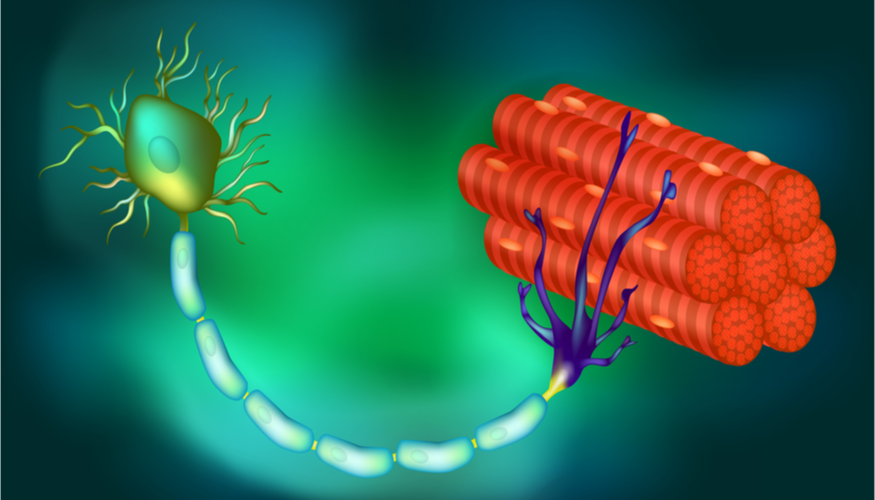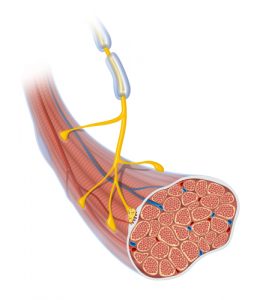SMA HCP Roundup, mid-February: X-linked infantile SMA, Risdiplam News & More

Research on SMA continues to forge ahead in 2020, with new results in from Roche’s latest investigation into its oral SMA drug, risdiplam. New tools for screening are being revealed as legislative changes are pushing more and more toward requiring infants born in the U.S. to be screened for SMA. Below is a roundup of the latest SMA news and research.
Understanding SMA
X-linked infantile spinal muscular atrophy (SMAX2) caused by novel c.1681G>A substitution in the UBA1 gene, expanding the phenotype.2
This article reports on a male patient with X-linked infantile SMA (SMAX2) who lacked contractures upon physical examination but who had mildly elevated creatine kinase and diffuse motor neuronopathy. Genetic tests revealed that the patient’s SMN1 gene was normal. However, sequencing of the ubiquitin like modifier-activating enzyme 1 (UBA1) gene showed a hemizygous familial variant that was maternally inherited. According to the authors, this variant has not previously been reported.
Read more here.
R-Roscovitine Improves Motoneuron Function in Mouse Models for Spinal Muscular Atrophy.3
In this article, scientists describe a preclinical study into the effects of R-Roscovitine, which modifies calcium channels and inhibits cyclin-dependent kinase 5 (Cdk-5), on a mouse model of SMA. In addition to improving survival, R-Roscovitine facilitated neurotransmission. Specifically, when applied to the neuromuscular junction, R-Roscovitine enhanced neurotransmitter release and the frequency of spontaneous miniature potentials and reduced the activation threshold at silent terminals. R-Roscovitine also increased the density of calcium channels and the sizes of motor endplates and restored both growth cone size and axon length in SMN-deficient motoneurons. The authors conclude that R-Roscovitine can improve calcium signaling, which is critical for motoneuron function.
Read more here.
Splicing Defects of the Profilin Gene Alter Actin Dynamics in an S. pombe SMN Mutant.1
This paper describes a study revealing a correlation between SMN dysfunction in snRNP assembly and actin dynamics defects. The authors identified this association by screening a type of yeast and posit that this finding not only elucidates details of SMA but also points to common features shared in the pathogenesis of SMA and ALS.
Read more here.
Treating SMA
 On-chip 3D neuromuscular model for drug screening and precision medicine in neuromuscular disease.4
On-chip 3D neuromuscular model for drug screening and precision medicine in neuromuscular disease.4
In this paper, researchers describe a protocol for a motor unit model that can be used to study SMA. The model is a 3D physiological and pathophysiological model that includes a microfluidic device containing motor neurons coupled to skeletal muscles. According to the authors, it could be useful for precision medicine applications, drug screening, and the assessment of disease risk.
Read more here.
Transforaminal lumbar puncture for intrathecal access: Case series with literature review and comparison to other techniques.5
Recently, a transforaminal approach to lumbar puncture has been gaining traction as a way to deliver therapy to patients with challenging spinal anatomy. In this report, the authors describe their strategy for this type of transforaminal lumbar puncture, with which they have had 100% success with SMA patients.
Read more here.
Recent Review:
- New treatments in spinal muscular atrophy: an overview of currently available data.6
This review covers the latest in therapeutic interventions for SMA, including the efficacy and safety of disease -modifying approaches like gene replacement therapy, antisense oligonucleotides, and splicing modifiers. The authors point to the importance of early intervention and the need for biomarkers to help identify responders from non-responders.
Read more here.
- Expanding therapeutic opportunities for neurodegenerative diseases: A perspective on the important role of phenotypic screening.7
In this review, the authors discuss the power of phenotypic screening and how it has uncovered non-antisense oligonucleotide splice modulators for SMA and helped to elucidate the mechanisms by which the modulators can influence the disease. According to the authors, the phenotypic screening approach could also provide value if applied to other neurodegenerative diseases.
Read more here.
SMA Management
The ICF-CY as a framework for the management of spinal muscular atrophy in the era of gene therapy: a proof-of-concept study.8
This proof-of-concept study used the International Classification of Functioning, Disability and Health for Children and Youth (ICF-CY) – a comprehensive documentation tool – to investigate the utility of the tool in the management of a child with SMA. Based on the results, the authors suggest that this tool can be valuable in SMA management, particularly at a time when nusinersen has led to changing SMA phenotypes.
Read more here.
 Trajectory of change in the swallowing status in spinal muscular atrophy type I.9
Trajectory of change in the swallowing status in spinal muscular atrophy type I.9
This paper describes a retrospective study into how swallowing dysfunction progresses over the first two years of life in those with SMA type 1. Based on the analysis of 11 patients, the authors conclude that deterioration varies significantly and so individualized approaches to swallowing dysfunction management are needed.
Read more here.
Preoperative Variables Associated With Respiratory Complications After Pediatric Neuromuscular Spine Deformity Surgery.10
In this article, researchers describe their investigation into factors associated with respiratory complications following posterior spinal fusion in pediatric patients with neuromuscular scoliosis. Based on their data, including data on 4 patients with SMA, the authors conclude that those undergoing posterior spinal fusion are at increased risk of postoperative respiratory complications if they have a history of pneumonia or if they have a gastrostomy tube present at the time of surgery.
Read more here.
Patient Focus and Policy Implications
Spinal Muscular Atrophy Diagnosed by Newborn Screening.11
This brief describes the output of a panel of experts across academia, industry, and family foundations who developed a treatment algorithm for those diagnosed with SMA through newborn screening.
Read more here.
Spinal Muscular Atrophy: New Screening System with Real-Time mCOP-PCR and PCR-RFLP for SMN1 Deletion.12
This paper describes a genotyping system that the authors conclude will be useful for screening for SMA. The method, which is a modified competitive oligonucleotide priming-PCR (mCOP-PCR) approach, involved the use of dry blood to rapidly point to the presence or absence of SMN1 and SMN2. Using PCR-restriction fragment length polymorphism (PCR-RFLP), the researchers verified the results of this newly developed technique.
Read more here.
 Spinal Muscular Atrophy: Advanced Version of Screening System with Real-Time mCOP-PCR and PCR-RFLP for SMN1 Deletion.13
Spinal Muscular Atrophy: Advanced Version of Screening System with Real-Time mCOP-PCR and PCR-RFLP for SMN1 Deletion.13
In this article, the same researchers who authored the above article describe a real-time mCOP-PCR method that allows for an even faster demonstration of the presence or absence of SMN1 and SMN2.
Read more here.
Nested PCR Amplification Secures DNA Template Quality and Quantity in Real-time mCOP-PCR Screening for SMA.14
Here, the same team describes the details of their mCOP-PCR screening system and how it leads to unambiguous results related to SMA.
Read more here.
SMA News
- Kean bill signed into law. Bipartisan legislation sponsored by Senate Republican Leader Tom Kean has been signed into the law. The legislation requires that infants who are born in New Jersey be tested for genetic markers of SMA. Read more here.
- Experimental oral drug for SMA showing promise. A study on the drug risdiplam has met its primary endpoints, demonstrating that infants with SMA type 1 who are between the ages of 1 and 7 months and treated with risdiplam for a year can sit without support for at least 5 seconds following treatment. Read more here.
References
1. Antoine M, Patrick KL, Soret J, et al. Splicing Defects of the Profilin Gene Alter Actin Dynamics in an S. pombe SMN Mutant. iScience. 2019;23(1):100809. doi:10.1016/j.isci.2019.100809
2. Shaughnessy N, Forman EB, O’Rourke D, Lynch SA, Lynch B. X-linked infantile spinal muscular atrophy (SMAX2) caused by novel c.1681G>A substitution in the UBA1 gene, expanding the phenotype. Neuromuscul Disord. November 2019. doi:10.1016/j.nmd.2019.11.004
3. Tejero R, Balk S, Franco-Espin J, et al. R-Roscovitine Improves Motoneuron Function in Mouse Models for Spinal Muscular Atrophy. iScience. 2020;23(2):100826. doi:10.1016/j.isci.2020.100826
4. Osaki T, Uzel SGM, Kamm RD. On-chip 3D neuromuscular model for drug screening and precision medicine in neuromuscular disease. Nat Protoc. January 2020. doi:10.1038/s41596-019-0248-1
5. Velayudhan V, Patel S, Danziger A, Grigorian A, Waite S, Efendizade A. Transforaminal lumbar puncture for intrathecal access: Case series with literature review and comparison to other techniques. J Clin Neurosci Off J Neurosurg Soc Australas. January 2020. doi:10.1016/j.jocn.2019.12.056
6. Ramdas S, Servais L. New treatments in spinal muscular atrophy: an overview of currently available data. Expert Opin Pharmacother. 2020;21(3):307-315. doi:10.1080/14656566.2019.1704732
7. Swalley SE. Expanding therapeutic opportunities for neurodegenerative diseases: A perspective on the important role of phenotypic screening. Bioorg Med Chem. December 2019:115239. doi:10.1016/j.bmc.2019.115239
8. Trabacca A, Lucarelli E, Pacifico R, Vespino T, Di Liddo A, Losito L. The ICF-CY as a framework for the management of spinal muscular atrophy in the era of gene therapy: a proof-of-concept study. Eur J Phys Rehabil Med. January 2020. doi:10.23736/S1973-9087.20.05968-7
9. Choi Y-A, Suh DI, Chae J-H, Shin H-I. Trajectory of change in the swallowing status in spinal muscular atrophy type I. Int J Pediatr Otorhinolaryngol. 2019;130:109818. doi:10.1016/j.ijporl.2019.109818
10. Luhmann SJ, Furdock R. Preoperative Variables Associated With Respiratory Complications After Pediatric Neuromuscular Spine Deformity Surgery. Spine Deform. 2019;7(1):107-111. doi:10.1016/j.jspd.2018.05.005
11. Lopez-Chacon M, Buehner AN, Rao VK. Spinal Muscular Atrophy Diagnosed by Newborn Screening. Pediatr Neurol briefs. 2019;33:5. doi:10.15844/pedneurbriefs-33-5
12. Niba ETE, Rochmah MA, Harahap NIF, et al. Spinal Muscular Atrophy: New Screening System with Real-Time mCOP-PCR and PCR-RFLP for SMN1 Deletion. Kobe J Med Sci. 2019;65(2):E44-E48.
13. Niba ETE, Rochmah MA, Harahap NIF, et al. Spinal Muscular Atrophy: Advanced Version of Screening System with Real-Time mCOP-PCR and PCR-RFLP for SMN1 Deletion. Kobe J Med Sci. 2019;65(2):E49-E53.
14. Wijaya YOS, Niba ETE, Rochmah MA, et al. Nested PCR Amplification Secures DNA Template Quality and Quantity in Real-time mCOP-PCR Screening for SMA. Kobe J Med Sci. 2019;65(2):E54-E58.

